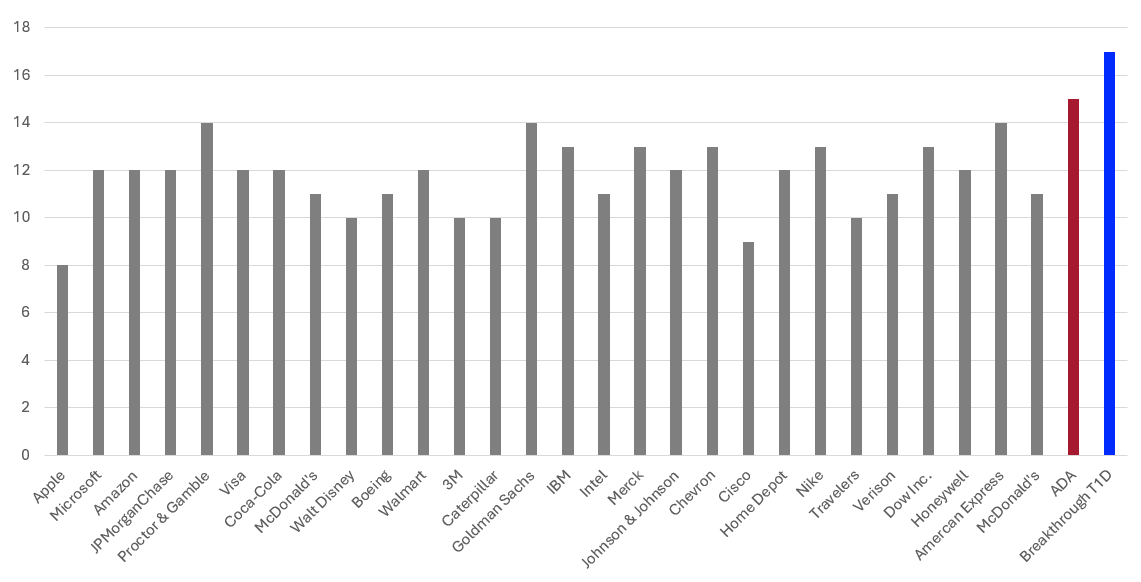
At a Glance
- The board of directors is the top governing body of nonprofit organizations.
- Board members have a fiduciary duty to ensure the entities they represent deliver on the priorities of stakeholders, shareholders, and donors. For T1D nonprofits, the priority is a cure.
- Over the past decade, both Breakthrough T1D and ADA have followed JDCA recommendations to optimize board size, with boards 55% lower today than in 2014.
- There are 5 key recommendations to improve board performance: 1) Board elections; 2) Following donor priorities; 3) Performance-based executive pay; 4) Say on pay; and 5) A dedicated Practical Cure initiative.
- Two issues need to be addressed by the boards: Maximizing cash use at Breakthrough T1D and restoring T1D community trust for the ADA.
In nonprofit organizations, the ultimate power and decision-making authority is held by the board of directors. Members have the responsibility to ensure the nonprofit delivers on its stated mission and achieves annual objectives. For T1D, boards are responsible for ensuring progress toward a cure is made as quickly as possible.
This is the 12th annual review of the board of directors at Breakthrough T1D and the American Diabetes Association (ADA), the two largest diabetes nonprofits. This report will address responsibilities, key challenges, and offer constructive recommendations.
Current board members are listed in Appendix A.
Board Responsibilities
Although the board holds ultimate authority, members typically do not get involved in day-to-day activities. One common phrase used to describe the boundaries of board responsibility is ‘noses in, fingers out’—members must stay informed and engaged with the larger strategy, direction, and mission, but let those doing the footwork make the smaller operational decisions.
Managing the CEO is one of the board’s most important jobs. The CEO reports to the board, which in turn evaluates performance and approves compensation. If the CEO is not fulfilling board expectations, they have the authority to remove and replace.
More specifically, a board member will be involved in:
- Mission change
- Executive compensation and recruitment
- Nonprofit rebranding
- Guiding executive leadership
- Ensuring high output from the nonprofit
- Other large, high-impact decisions
Fiduciary Duty
Boards have a legal and moral duty to ensure the organization's mission is fulfilled as efficiently as possible. In a for-profit company, board members—individually or as a whole—can be sued in a court of law by shareholders if they do not fulfil these duties. The same can and should be true of nonprofit board members who, we argue, have a similar duty to all donors.
Optimizing Board Size and Experience
Two key characteristics of an effective board are the number and experience of its members. The optimal board size varies by industry and needs. In all cases, it should not be so large that it cannot engage in meaningful discussion, nor so small that it lacks diverse viewpoints. Successful for-profit companies find that the sweet spot of board size is somewhere between eight and fourteen members (see chart A).
To maximize impact, the board should include a range of experiences. Generally, boards include people whose professional experiences are invaluable to delivering on mission and fulfilling stockholder or donor expectations. Typical boards comprise of experts in law, banking, operations, relevant academic topics, unique specialized skills, and complementary industries.
One historical challenge of nonprofits is that many choose board members based on financial contributions raised for the organization. This often results in very large boards with members whose high-value skills are limited to fundraising.
This was true with both Breakthrough T1D and ADA when JDCA did its first review in 2014. ADA held a total of thirty-eight members; Breakthrough T1D held thirty-four (see chart B). However, over the past decade, Breakthrough T1D and the ADA’s boards have reduced with JDCA recommendations. Today, Breakthrough T1D’s International Board of Directors has seventeen and ADA has fifteen members.
Chart A: 2025 For-Profit vs. Breakthrough T1D and ADA Board Size

Chart B: Historical Board Size 2014-2025

Recommendations
JDCA offers five key recommendations to nonprofit boards that would heighten performance, strengthen public trust, and ultimately accelerate a Practical Cure. These suggestions are informed by best practices from the for-profit sector while acknowledging the unique circumstances of the nonprofit environment.
We have offered many of these recommendations in the past, but they are as apt today as in any prior year. If adopted, it would be a win-win for both T1D nonprofits and the communities they serve.
- Elect board members from without, not from within. Today, nonprofit board members can only be appointed or removed by fellow members. Election by a broad base of donors would foster accountability and ensure alignment between nonprofit and donor.
- Deploy resources in line with donor priorities. Nine out of ten T1D donors want cure research to be the top priority for diabetes charities.
- Performance-based executive pay. Borrow for-profit best-practice compensation habits. Enact genuine, measurable objectives that weigh pay against delivering on mission and Practical Cure progress. Pay well for real advances.
- Enact a ‘Say on Pay’ executive compensation structure. A ‘say on pay’ initiative would allow donors—the for-profit equivalent to shareholders—to vote on aspects of executive compensation like pay structure, base pay, and bonus amounts to influence a realistic compensation policy.
- Establish a dedicated Practical Cure program. A focused, transparent cure initiative with measurable goals—and a dedicated leader accountable for its progress—would build trust and drive Practical Cure progress. Breakthrough T1D’s Project ACT is a move in this direction, but falls short in some key areas.
Special: Call-Out Issues for Board Resolution
ADA: Winning Back the T1D Community (before it’s too late)
The ADA continues to lose footing in the T1D community by prioritizing T2D and obesity. In FY24, only 2% of revenue went to T1D research grants, 16% to any research. JDCA encourages the board to repair its reputation in the community by adopting clear, T1D-focused goals that solidify type 1 as a priority. If not, then it becomes a question of when the ADA will shift entirely from autoimmune diabetes to a sole T2D and insulin resistance focus. This is a board decision.
Breakthrough T1D: Utilizing Cash Stash to Accelerate a Cure
Breakthrough T1D built a large stash of unused cash and short-term investments of about $178 million. This money could be used to provide stability in the event of a financial crisis, a good thing. However, as a nonprofit, it has a fiduciary duty to efficiently deploy those funds to progress the organization’s ultimate purpose—accelerating a cure. We argue that a portion of these funds should be used now to unlock the next stage of cure breakthroughs. This, too, is a board decision.
Appendix A: Board of Directors
Breakthrough T1D International Board
Lisa F. Wallack, Chair
Matt Varey, Vice Chair
Carlton McMillan
Chris Turner
Claudia Graham
Drayton Virkler
Elizabeth Caswell
Janet Woodcock (new)
Jen Schneider
Jeremy Lott (new)
Joseph (Joe) P. Lacher, Jr.
Karen Jordan
Karey L. Witty
Michael Alter
Mike Boyle (new)
Mike Gordon
Per Lundin
American Diabetes Association Board
Christopher K. Ralston, Chair
Charles Henderson, CEO
Amy Hess Fischl (new)
Enrique Caballero (new)
Francisco Prieto
Gretchen Youssef (new)
James Tai
Joshua J. Neumiller
Mandeep Bajaj
Mario Rivera (new)
Patti Urbanski
Rhodes B. Ritenour
Robin Richardson
Rodica Busui (Pop-Busui)
Sean Pittman
